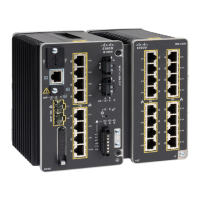33-9
Cisco IE 3000 Switch Software Configuration Guide
OL-13018-01
Chapter 33 Configuring EtherChannels and Link-State Tracking
Configuring EtherChannels
Default EtherChannel Configuration
Table 33-3 shows the default EtherChannel configuration.
EtherChannel Configuration Guidelines
If improperly configured, some EtherChannel ports are automatically disabled to avoid network loops
and other problems. Follow these guidelines to avoid configuration problems:
• Do not try to configure more than 6 EtherChannels on the switch.
• Configure a PAgP EtherChannel with up to eight Ethernet ports of the same type.
• Configure a LACP EtherChannel with up to16 Ethernet ports of the same type. Up to eight ports can
be active, and up to eight ports can be in standby mode.
• Configure all ports in an EtherChannel to operate at the same speeds and duplex modes.
• Enable all ports in an EtherChannel. A port in an EtherChannel that is disabled by using the
shutdown interface configuration command is treated as a link failure, and its traffic is transferred
to one of the remaining ports in the EtherChannel.
• When a group is first created, all ports follow the parameters set for the first port to be added to the
group. If you change the configuration of one of these parameters, you must also make the changes
to all ports in the group:
–
Allowed-VLAN list
–
Spanning-tree path cost for each VLAN
–
Spanning-tree port priority for each VLAN
–
Spanning-tree Port Fast setting
• Do not configure a port to be a member of more than one EtherChannel group.
Ta b l e 33-3 Default EtherChannel Configuration
Feature Default Setting
Channel groups None assigned.
Port-channel logical interface None defined.
PAgP mode No default.
PAgP learn method Aggregate-port learning on all ports.
PAgP priority 128 on all ports.
LACP mode No default.
LACP learn method Aggregate-port learning on all ports.
LACP port priority 32768 on all ports.
LACP system priority 32768.
LACP system ID LACP system priority and the switch MAC address.
Load balancing Load distribution on the switch is based on the
source-MAC address of the incoming packet.
